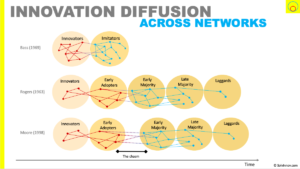Any writing on innovation needs to cover some essentials. And that is exactly what this journey does – with some extras! We’ll look at how innovations spread – diffusion; how they gain traction – adoption; the often missed aspect of resistance; and how to avoid innovation theatre.
We’ll get a deeper knowledge of the challenges and solutions to diffusion and adoption. And do so in a different from normal way: a network-first manner. Bass, Rogers, Moore, Gladwell (the tipping point) and the big/little hire of Christensen’s jobs to be done theory are all looked at. As well as a grounding on the types of resistance and what can cause it. Just remember the first version, and ultimate failure, of Google Glass.
First, we’ll expose a new definition of innovation. One that is built out from service-dominamt logic and a new view of value. Focused around helping beneficiaries make progress (functional and non-functional) better than they can currently.
And, we’ll explore something that many of us miss. Or simply don’t know of. Innovation resistance. We tend to believe that all innovation is good and we just need to get it diffused and adopted. But beneficiaries often resist innovation. Why? And What can we do? We’ll find out.
Moreover, we need to make sure our innovation activities don’t descend into innovation theatre. That is, performing activities that ultimately lead to no tangible outcome. You’ll recognise the feel good factor of running an innovation campaign across your enterprise but really the tangible returns have been low? That’s innovation theatre.
As we close this journey we’ll look at some of the maths behind Bass’ diffusion model. You don’t need to dig into this. But it’s kind of fun, and has all sorts of applications. And finally, we’ll take a quick peek on how network structures can alter the diffusion rates. Which implies we can harness network theory to our advantage (influencers, anyone?)








